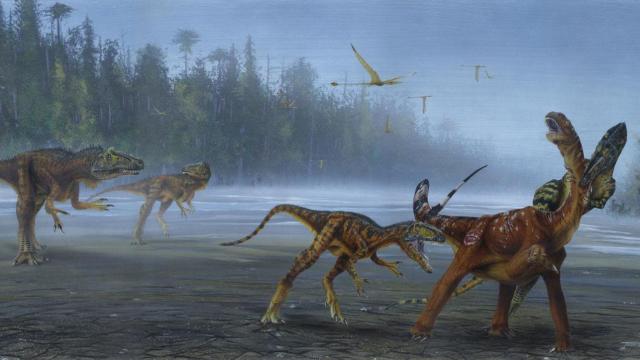One of the things that really bugs me about the Jurassic Park movies is the prominent role given to Tyrannosaurus rex—a dinosaur that didn’t appear until the ensuing Cretaceous period. I am therefore thrilled to learn about Allosaurus jimmadseni, a newly described apex predator that, unlike T. rex, actually lived during the Jurassic and was sufficiently terrifying enough to star in Hollywood films.
Take a look at Allosaurus jimmadseni, an 8- to 9-metre-long (26- to 29-foot), 4,000-pound carnivore that lived in North America between 157 million and 152 million years ago. As the youngest species of Allosaurus in the fossil record, it’s shedding new light on the evolution of this critically important group of carnivorous dinosaurs. Details of this newly described species were published today in the open access science journal PeerJ.
Allosaurus were a super-successful group of theropods—two-legged, three-toed dinosaurs with hollow bones—that lived during the Late Jurassic, and they represent some of the best-known dinosaurs in paleontology. That said, well-preserved, complete skeletons are rare, and most finds tend to involve scattered remains. For the new study, paleontologist Mark Loewen from the Natural History Museum of Utah, along with his sole co-author Daniel Chure, a retired paleontologist from the Dinosaur National Monument in Utah, described A. jimmadseni based on two nearly complete skeletons and various fossils collected over the years.
Despite its early position in the Allosaurus family tree and some primitive features compared to its successors, this theropod was an absolute beast. A. jimmadseni lived in the semi-arid floodplains of western North America, dominating a territory that covered what is today Utah, Colorado, and Wyoming. With no suitable rivals to threaten its ecological position as top predator, A. jimmadseni hunted large prey with impunity, feasting upon herbivores such as Stegosaurus, Diplodocus, and various sauropods.
To do so, the bipedal carnivore used three sharp grasping claws at the end of it arms and its 80 or so serrated, razor-sharp teeth, according to the new study. Loewen and Chure estimated its bulk to be roughly half that of T. rex, which appeared some 70 million years later.
Fossilized remains of A. jimmadseni were pulled from the Morrison Formation, a large expanse of sedimentary rock in the western United States. Since the late 19th century, troves of Allosaurus bones have been pulled from these rocks, but paleontologists are in disagreement about the number of Allosaurus species that can be associated with these fossils, with a wild discrepancy ranging from a single species to a dozen distinct species. The new study provides evidence of just two, the previously known A. fragilis and the newly described A. jimmadseni.
Loewen and Chure analysed two nearly complete specimens, one unearthed in Utah in 1990 (designated DINO 11541) and one found in Wyoming in 1991 (designated MOR 693). A mishmash of other Allosaurus bones were also included in the study, some of which were found to belong to the newly described species.
The history of DINO 11541 is actually quite interesting. Unearthed by paleontologist George Engelmann from the University of Nebraska, this fossil was so big that explosives were used to separate it from the surrounding rock. A helicopter was then brought in to fly out the 6,000-pound block. Researchers at the Dinosaur National Monument needed seven years to prepare the bones for analysis. Also, when DINO 11541 was first discovered, the paleontologists could not locate its skull, but because the head was mildly radioactive, it was finally recovered in 1996 by Ramal Jones from the University of Utah, who used a radiation detector to sniff-out the gamma rays emanating from the skull (radioactive fossils are a natural occurrence).
Specimen MOR 693 is more commonly known as “Big Al,” and it was incorrectly thought to be A. fragilis. The new study now clears up this misconception.
Loewen and Chure detected a number of physical features that distinguished A. jimmadseni from other species, including from A. fragilis, a close relative that lived 5 million years later. As described in the new paper, A. jimmadseni had a short, narrow skull, and low facial crests that protruded from horns in front of its eyes, among other unique characteristics. Compared to A. fragilis, it had a weaker skull and a narrower stereoscopic field of view. A. jimmadseni, therefore, can be seen as a kind of older model when compared to the high-tech allosaurids that followed in its evolutionary wake.
[referenced url=” thumb=” title=” excerpt=”]
Paleontologist Steven Brusatte, a University of Edinburgh paleontologist not involved with the new study, said this is an important and much-anticipated study.
“I’ve been waiting for this paper for about 20 years now, ever since I started studying dinosaurs as an undergraduate and heard rumours of a new Allosaurus species from the western USA,” explained Brusatte. “Everybody knows Allosaurus, or thinks they know Allosaurus. But here we are, nearly 150 years after the first Allosaurus bones were found, and after dozens and dozens of skeletons have been collected, and it turns out there is another species. This goes to show that we need to keep looking for fossils, keep being persistent in studying the fossils we have, and keep reassessing all of the evidence… There are many more dinosaurs out there to find.”
So while the Jurassic may not have featured giant carnivores like T. rex or Spinosaurus, it still had its share of reasonably large and ferocious predators. As the new study shows, Allosaurus was an ominous sign of even bigger things to come.
